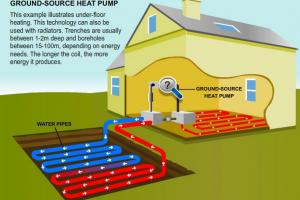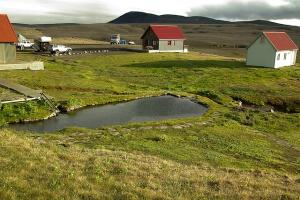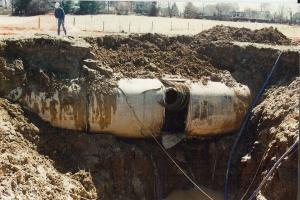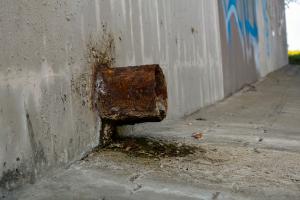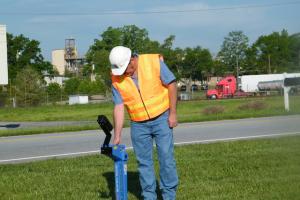Techniques for Sewer Condition Assessment
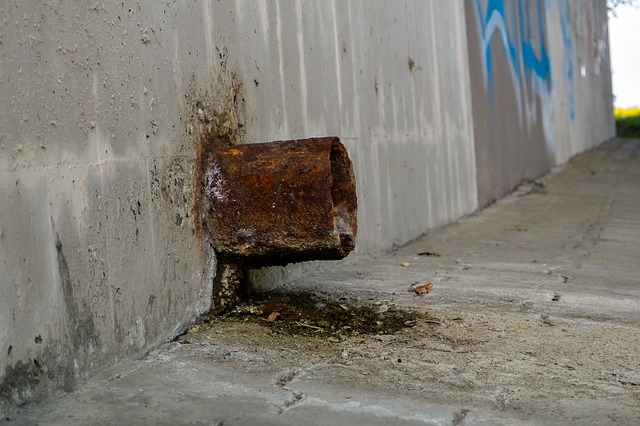
Methods for Sewer Condition Assessment
Sewer condition assessment involves evaluating the state of sewer infrastructure to identify defects, and potential risks, and prioritize maintenance or repair activities. Here are some commonly used techniques for sewer condition assessment:
Closed-Circuit Television (CCTV) Inspection:
CCTV cameras mounted on remotely controlled robots or pushed manually through the sewer pipes provide a visual inspection. Operators analyze the footage to detect cracks, leaks, blockages, and other structural issues.
It is the most widely used technology for sewers in the past 30+ years. The usage of CCTV cameras for condition assessment of sewers depends upon the expertise, alertness, and judgment of field technicians or camera operators for the identification and classification of defects.
Advances in colored image enhancements, pan-and-tilt camera heads, steerable crawler systems, and lighting arrangements have enabled CCTV cameras to carry out detailed surveys and assessments. A cable drum with a counter to measure distance inside sewers connects the camera to the surface while a computerized control unit for controlling the camera, lighting, and crawler movement usually hosted in a van accompanies the CCTV system
Laser Profiling for Sewer Assessment:
This technique utilizes laser technology to measure the dimensions of the sewer pipes accurately. It helps identify deformations, structural integrity problems, and the buildup of sediment or debris.
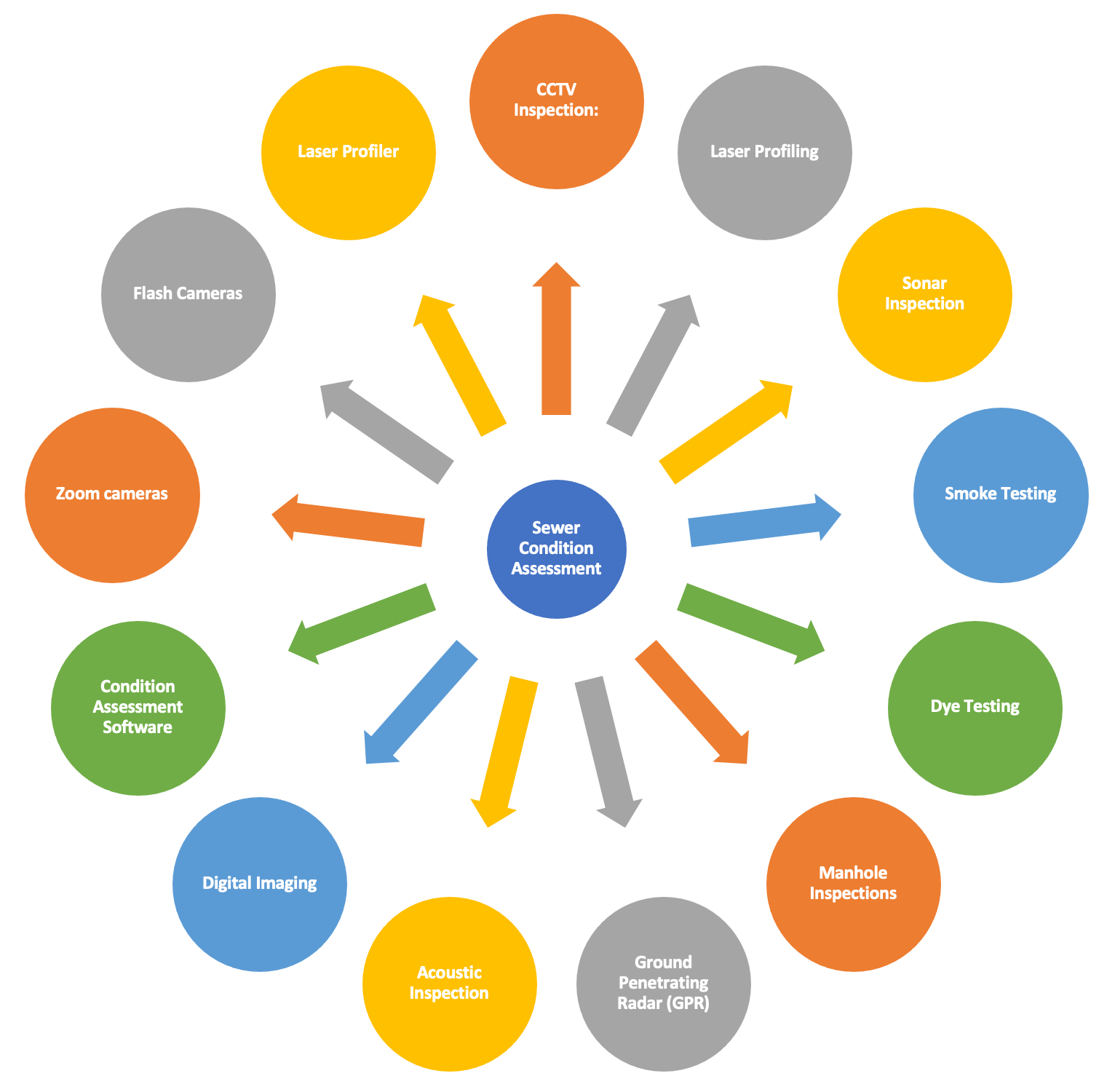
Sonar Inspection for Sewer Condition Assessment:
Sonar equipment uses sound waves to assess the condition of sewer pipes. By emitting and receiving sound signals, it can detect defects such as cracks, breaks, blockages, or even the presence of infiltration or exfiltration.
Smoke Testing:
Smoke is introduced into the sewer system, and its movement above ground is observed. Leaks or defects in the pipes can be identified by the presence of smoke. This method helps locate sources of infiltration or exfiltration.
Dye Testing:
A colored dye is introduced into the sewer system, and its appearance in nearby water bodies or structures indicates the presence of leaks or connections that should not exist. It is useful for identifying illegal connections or cross-contamination.
Manhole Inspections:
Manholes are inspected to evaluate their structural condition, including the presence of cracks, corrosion, or other signs of deterioration. This method also provides access points for other inspection techniques.
Ground Penetrating Radar (GPR):
GPR uses electromagnetic waves to detect objects and changes in material properties underground. It can identify pipe locations, voids, and other anomalies that may affect sewer infrastructure.
Acoustic Inspection:
By analyzing the sound patterns generated by water flow or equipment within the sewer system, an acoustic inspection can identify obstructions, blockages, or other issues affecting the flow.
Digital Imaging:
Advanced technologies like 3D imaging and laser scanning can create detailed visual representations of sewer infrastructure. This allows for accurate measurements, defect detection, and virtual inspections without physical presence.
Condition Assessment Software:
Utilizing data collected from various inspection techniques, specialized software can analyze and prioritize maintenance or repair activities based on the severity and impact of identified defects.
These techniques, used individually or in combination, help assess sewer condition, prioritize maintenance efforts, and make informed decisions about repairs or replacements, contributing to the overall management and improvement of sewer infrastructure.
Zoom cameras
- These cameras allow for quick and efficient preliminary inspections of sewer pipes. Instead of manually inspecting the entire length of the sewer, the camera can be remotely operated to focus on specific areas of interest, such as maintenance holes where most problems occur. This targeted approach saves time and resources by avoiding unnecessary inspections.
- Zoom cameras in sewer condition assessment are particularly useful for inspecting areas near maintenance holes since these locations are often prone to issues such as blockages, leaks, or structural damage. The camera can be positioned to capture detailed imagery and provide a close-up view of potential problem areas.
- Zoom cameras are designed to provide Good quality imagery up to 20-75 m pipe length. The zoom function allows operators to adjust the focal length, enabling clear visualization of the pipe walls and any defects or obstructions present. This capability ensures accurate assessment and detection of issues along the entire length of the inspected pipe.
- Zoom cameras are versatile and capable of surveying sewer pipes with different diameters. They can be used to assess pipes ranging from 150 mm to 1525 mm in diameter, providing flexibility in sewer condition assessment for a wide range of infrastructure.
- Zoom cameras capture color videos and digital images during inspections. The optical storage devices, such as hard drives or memory cards, are used to store the recorded footage. This allows for easy review and analysis of the inspection results, as well as sharing the findings with relevant stakeholders.
Flash Cameras
-
Two high-resolution cameras with 186 degrees wide-angle lenses: Flash cameras used in sewer condition assessment typically incorporate two high-resolution cameras positioned at the front and rear ends of the system. These cameras are equipped with wide-angle lenses, specifically with a 186-degree field of view. This wide-angle capability allows for comprehensive coverage and captures a broad perspective of the sewer pipe during inspections.
-
Hemispherical digital images for a 360-degree spherical image: Flash cameras capture hemispherical digital images as they move through the sewer pipe. These images are then combined to form a complete 360-degree spherical image of the interior of the pipe. This panoramic view provides a comprehensive visualization of the condition of the sewer, allowing for a detailed assessment of defects and abnormalities.
-
Measurement of defects and objects on unfolded images: The captured hemispherical images can be unfolded or flattened to create a two-dimensional representation of the sewer pipe's interior. This unfolded image enables the measurement and analysis of defects and objects within the pipe. By accurately measuring the dimensions of defects, such as cracks, fractures, or deformations, appropriate remedial actions can be planned.
-
Working in pipes with a diameter of 200mm & up and operating speed of 20 meters per minute: Flash cameras are designed to operate in sewer pipes with a diameter of 200mm and larger. This diameter range covers a significant portion of sewer infrastructure. Additionally, these cameras are capable of inspecting pipes at a speed of 20 meters per minute, allowing for efficient and timely assessments of long sections of the sewer network.
Laser Profiler
-
The laser profiler is used in conjunction with Closed-Circuit Television (CCTV) cameras for sewer condition assessment. The CCTV camera provides visual footage of the sewer pipe, while the laser profiler adds an additional layer of measurement and analysis capabilities.
-
Determination of internal condition and measurement of defects and other features: The laser profiler is specifically used to assess the internal condition of the sewer pipe. It helps in measuring various features and defects within the pipe, such as deformations, cracks, offsets, and sediment deposits. By providing precise measurements, the profiler assists in identifying the severity and extent of the identified issues.
-
The laser profiler operates by projecting a ring of laser light onto the internal surface of the sewer pipe. This ring of light creates a distinct pattern on the pipe wall. A CCTV camera captures the laser image, which includes the illuminated ring of light and the surrounding pipe surface.
-
The captured laser image is processed using laser profiler software. The software analyzes the pattern and characteristics of the ring of light to extract information about the pipe's profile. It calculates the dimensions, slopes, and irregularities of the pipe based on the distortion and deformation of the projected ring caused by the pipe's internal condition.
-
The laser profiler software generates a digital profile of the sewer pipe based on the analysis of the ring of light. This digital profile provides a detailed representation of the pipe's internal geometry, including its cross-sectional shape and any variations along its length. The digital profile helps in identifying structural defects and irregularities within the pipe.




